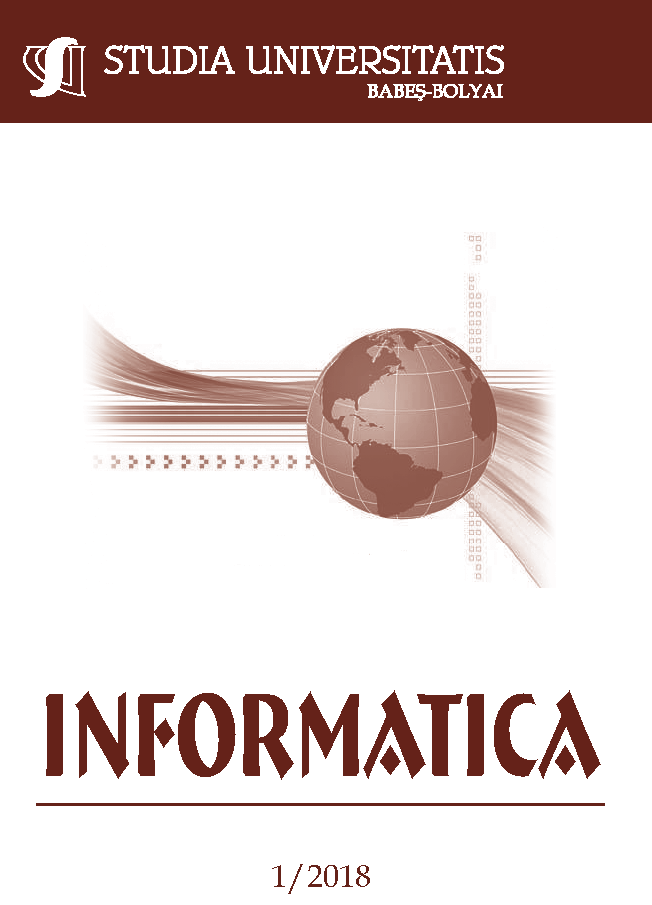TOWARDS GREEN COMPUTING IN ERLANG
DOI:
https://doi.org/10.24193/subbi.2018.1.05Keywords:
green computing, energy efficiency, Erlang, RAPL.Abstract
Energy efficiency in computing was identified as low energy usage of the hardware for a while. However, nowadays, we can talk about energy efficiency in terms of software as well. Therefore, we have to investigate how the different design decisions and programming language constructs affect the energy consumption. The green computing is a relatively new research area, guidelines are required for the software developers in terms of energy efficiency. In our research we are focusing on the functional programming language Erlang. We have investigated the effect of different language constructs (such as higher order functions), parallelism, data structures and styles of programming on energy usage. Additionally we present a tool to measure and visualise the consumed energy.
References
Joe Armstrong. Programming Erlang. The Pragmatic Bookshelf, 2nd edition, October 2013. ISBN 978-1-93778-553-6.
Srinivas Pandruvada. Running Average Power Limit-RAPL. https://01.org/blogs/2014/running-average-power-limit-rapl. [Accessed: 03.10.2018.].
Vincent M. Weaver. Reading RAPL energy measurements from Linux. http://web.eece.maine.edu/vweaver/projects/rapl/. [Accessed: 03.10.2018.].
Istv´an Boz´o, D´aniel Horp´acsi, Zolt´an Horv´ath, R´obert Kitlei, Judit K˝oszegi, M´at´e Tejfel, and Melinda T´oth. RefactorErl, Source Code Analysis and Refactoring in Erlang. In Proceeding of the 12th Symposium on Programming Languages and Software Tools, Tallin, Estonia, 2011.
Zolt´an Horv´ath, L´aszl´o L¨ovei, Tam´as Kozsik, R´obert Kitlei, Anik´o Nagyn´e V´ıg, Tam´as Nagy, Melinda T´oth, and Roland Kira´ly. Modeling Semantic Knowledge in Erlang for Refactoring. In Proceedings of the International Conference on Knowledge Engineering, Principles and Techniques, KEPT 2009, volume 54(2009) Sp. Issue of Studia Universitatis Babe¸s-Bolyai, Series Informatica, pages 7–16, Cluj-Napoca, Romania, July 2009.
Rui Pereira, Marco Couto, J´acome Cunha, João Paulo Fernandes, and João Saraiva. The Influence of the Java Collection Framework on Overall Energy Consumption. CoRR, abs/1602.00984, 2016. URL http://arxiv.org/abs/1602.00984.
Gustavo Pinto, Fernando Castor, and Yu David Liu. Understanding Energy Behaviors of Thread Management Constructs. SIG-PLAN Not., 49(10):345–360, October 2014. ISSN 0362-1340. doi:10.1145/2714064.2660235.
A. P. Chandrakasan, S. Sheng, and R. W. Brodersen. Low-power CMOS digital design. IEEE Journal of Solid-State Circuits, 27(4):473–484, Apr 1992. ISSN 0018-9200. doi: 10.1109/4.126534.
V. Tiwari, S. Malik, and A. Wolfe. Power analysis of embedded software: a first step towards software power minimization. IEEE Transactions on Very Large Scale Integration (VLSI) Systems, 2(4):437–445, Dec 1994. ISSN 1063-8210. doi: 10.1109/92.335012.
C. Sahin, P. Tornquist, R. Mckenna, Z. Pearson, and J. Clause. How Does Code Obfuscation Impact Energy Usage? In 2014 IEEE International Conference on Software Maintenance and Evolution, pages 131–140, Sept 2014. doi: 10.1109/ICSME.2014.35.
Cagri Sahin, Lori Pollock, and James Clause. How Do Code Refactorings Affect Energy Usage? In Proceedings of the 8th ACM/IEEE International Symposium on Empirical Software Engineering and Measurement, ESEM ’14, pages 36:1–36:10, New York, NY, USA, 2014. ACM. ISBN 978-1-4503-2774-9. doi: 10.1145/2652524.2652538.
L. G. Lima, F. Soares-Neto, P. Lieuthier, F. Castor, G. Melfe, and J. P. Fernandes. Haskell in Green Land: Analyzing the Energy Behavior of a Purely Functional Language. In 2016 IEEE 23rd International Conference on Software Analysis, Evolution, and Reengineering (SANER), volume 1, pages 517–528, March 2016. doi: 10.1109/SANER.2016.85.
Jessica Tatiana Carrasco Ortiz. Green computing in Erlang, 2017.
Filipe Varj˜ao. Measuring Erlang energy consumption, and why this matters. http://www.erlang-factory.com/sfbay2017/filipe-varjao.html. [Accessed: 03.10.2018.].
Wander Lairson Costa. Power profiling overview. https://developer.mozilla.org/en-US/docs/Mozilla/Performance/Power profiling overview, [Accessed: 03.10.2018.].
J. D. Hunter. Matplotlib: A 2D graphics environment. Computing In Science & Engineering, 9(3):90–95, 2007. doi: 10.1109/MCSE.2007.55.
Ericsson. Erlang Efficiency Guide, Processes. http://erlang.org/doc/efficiency guide/processes.html. [Accessed: 03.10.2018.].
Downloads
Published
How to Cite
Issue
Section
License
Copyright (c) 2018 Studia Universitatis Babeș-Bolyai Informatica

This work is licensed under a Creative Commons Attribution-NonCommercial-NoDerivatives 4.0 International License.





